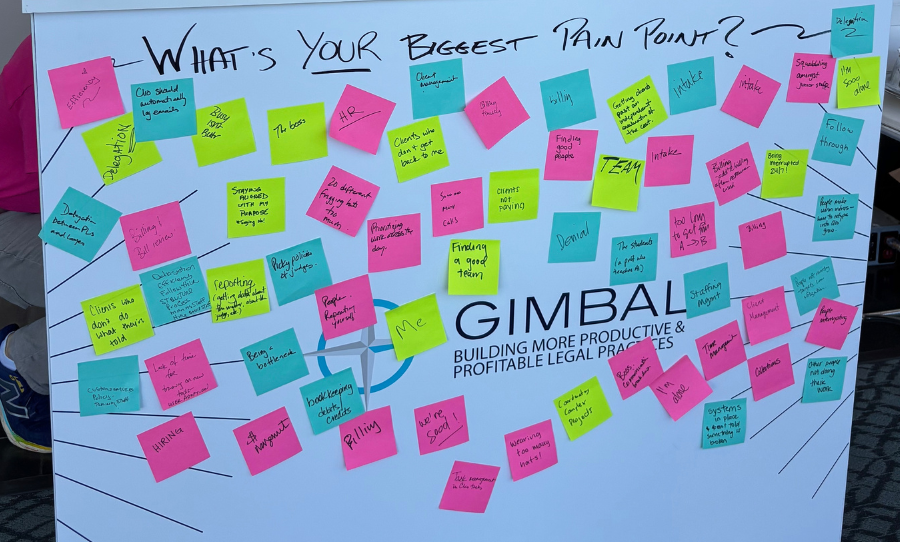E213: Discover the Key to Legal Process Success: Implementing with Precision (Part 3)
Dec 27, 2023
Welcome to the final installment of our series, Inside a Legal Process Improvement Project.
In Part 1, we explained the preparation.
In Part 2, we described process mapping.
In this, Part 3, we’ll explain the last steps: creating an implementation plan and then the biggie: actually implementing it.
Day 3’s objective was to create an implementation plan with fixed goals, timelines, and responsibilities. The team had generated a lot of improvement opportunities—small and large—over the course of the first two days. It was time to take a hard look at each idea and start prioritizing.
You should note that an improvement opportunity is not a solution, or even a potential solution. Rather, it is a point in the process that the team has decided needs to be improved.
To help the team prioritize their many improvement opportunities, we used a PICK chart.
A PICK Chart is a simple two-by-two matrix that pits the ease of implementation against the potential impact of the improvement (the payoff).
Easy-to-implement opportunities with big payoffs should be the first ones you tackle. They go in the “implement” quadrant. Tougher ones fall into the “possible” or “challenge” quadrants. The hardest-to-implement, lowest-impact improvement opportunities go in the “kill” quadrant. But we never want to lose great ideas. Things that seem difficult to address now may become much easier over time.
We always recommend parking those ideas and returning to them later (whether in 3, 6, 9 months or more), working continuously to find ways to make them possible.
The team used the PICK chart to develop a working list of the opportunities they wanted to focus on. We also encouraged the team to designate an execution method for each one.
Execution methods help with timeline development.
Some improvement opportunities are so simple that they can be designated Just Do It (JDI). Teams can start work on them right away, or as soon as their schedule permits, and see almost immediate results. Other improvements require more effort because of their complexity or the number of people that have to be involved. They may be designated either Kaizen Events—short, 2 to 3 day intense improvement efforts—or longer-term Projects.
Once the team decided on the execution method, we helped them develop a realistic timeline that took into account their workload, budget, and availability. Team members eagerly assumed responsibility for the improvement opportunities, and began thinking about participants for their individual improvement teams.
In fact, by the end of Day 3, one of the JDIs was already being tested. It was a very inexpensive improvement they estimated would save about 45 minutes of time on the simple incorporations, and much more for complex ones. The instant win got the team off to an excellent start.
The end result was an implementation plan that consisted of 15 separate improvement opportunities. Individual team members voluntarily assumed responsibility for carrying forward improvement opportunities in areas they had some authority over or projects there were excited about. They committed to their improvements and they committed to the timeline. All of this was recorded in the plan.
Many of the opportunities were JDIs, with a few longer-term projects that were expected to take 3-4 months to complete. The plan contained scheduled review dates as well, to maintain momentum and ensure that individual teams got support if they stalled.
So what’s next? The hard work: implementation. Remember, the implementation plan identifies opportunities for improvement. Over the course of a mapping project, a team may develop many ideas about the changes required to realize those improvements. But before they can implement them, they have to take a step back. Why? Because they need to be sure those changes will address the root causes of the problems they are looking to correct.
Each improvement opportunity becomes a mini-project that requires teams to work through the DMAIC framework. Define and build a business case. Gather information and data. Find the root cause. Brainstorm solutions. Test potential improvements. Check to see if those improvements produce the desired results, and build the controls to prevent backsliding into the old way of doing things.
We support our clients as much as necessary through the implementation stage. The firm working on incorporations didn’t need much ongoing support from us, because they already have people on-site dedicated to their improvement initiatives. In fact, our work with them was designed, in part, to train their in-house team. Other firms require more regular assistance, troubleshooting, and guidance. For those teams, we schedule regular follow-up calls, remote support, and on-site meetings.
Key Takeaways from this series:
- Set an achievable, realistic goal.
- Scope your project carefully and stick to the boundaries you set.
- Don’t worry about fancy mapping software. All you need is a good team, flip charts, some markers, a whole lot of stickies, and plenty of wall space.
- Follow the DMAIC framework (more tips on this coming up next month!)
- Don’t assume anything and certainly don’t jump to solutions.
- Remember that improvement doesn’t end at 5 o’clock on Day 3 of a process improvement event. Law firms and legal departments that view improvement as a continuous, cultural necessity see the greatest results.
If you’re ready to improve your processes, set up a time to meet with us! We offer a free 30-minute strategy session and would love to see how Gimbal can help you achieve your goals and build a practice you love.
Success in your inbox!
Sign up for our Productivity Tips. You'll get a one tip and one featured article each month, both packed with practical, actionable advice that will help you build a more profitable, productive practice.
We will provide you with practice management tips and related information and offers. We will never sell your information, for any reason. Unsubscribe at any time.


